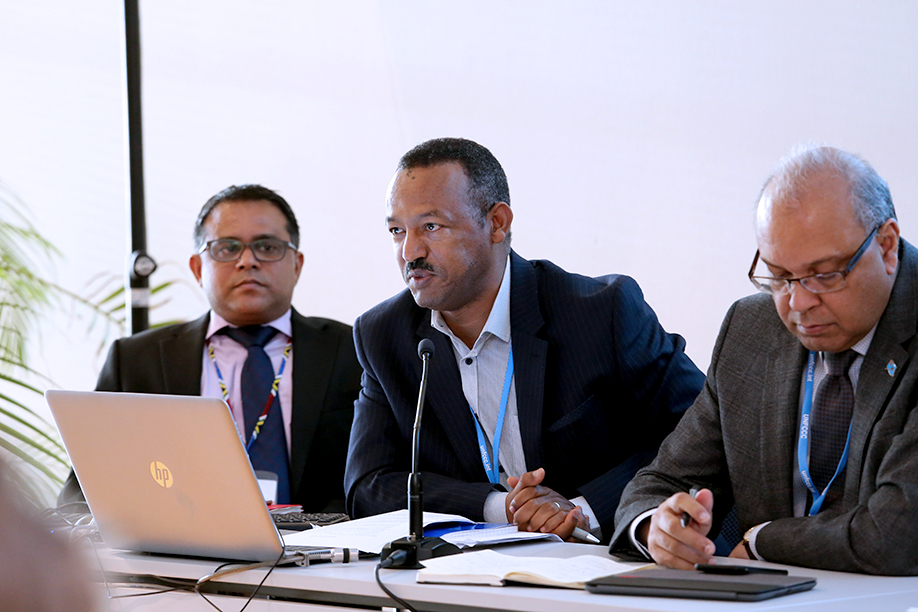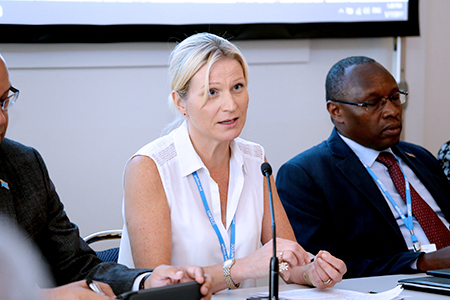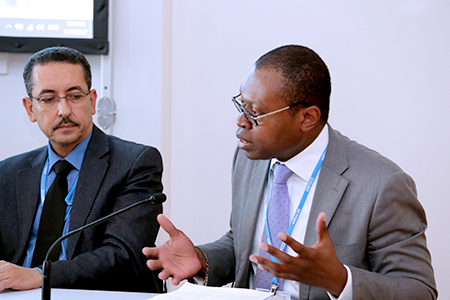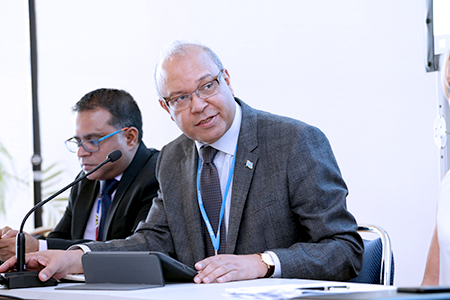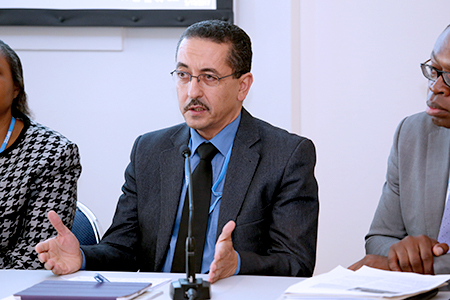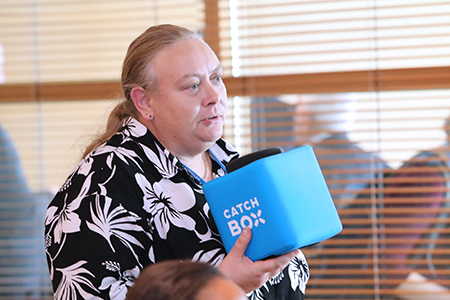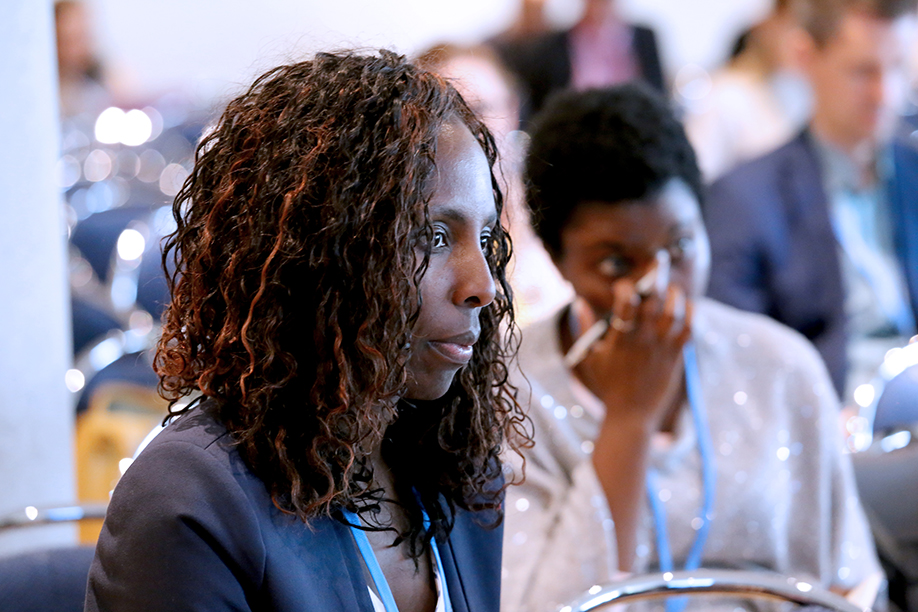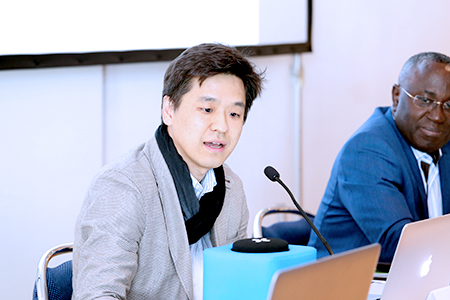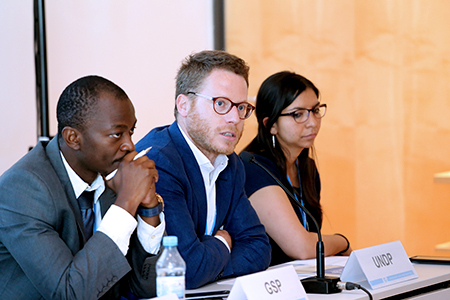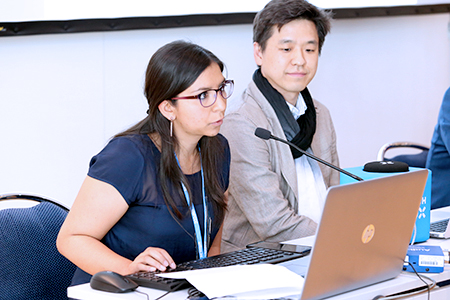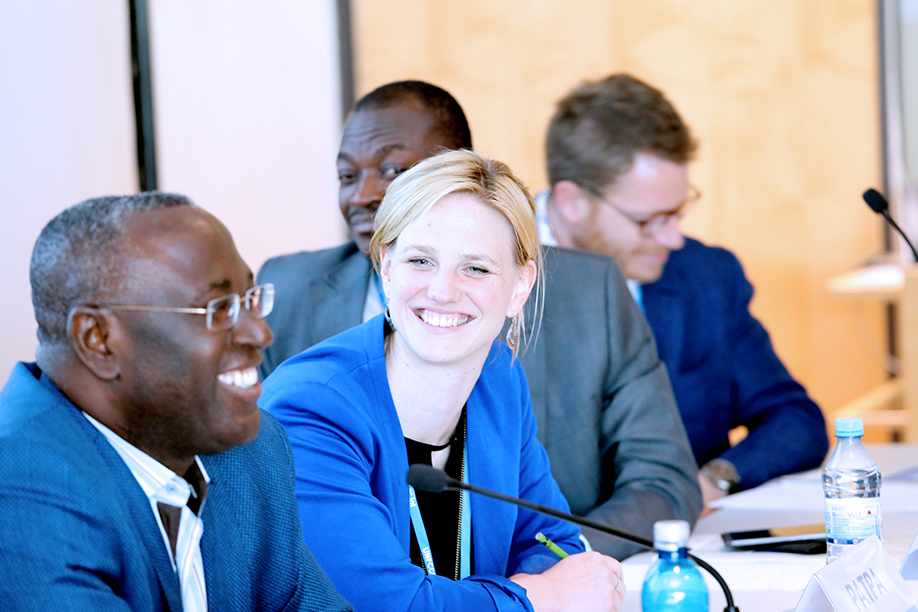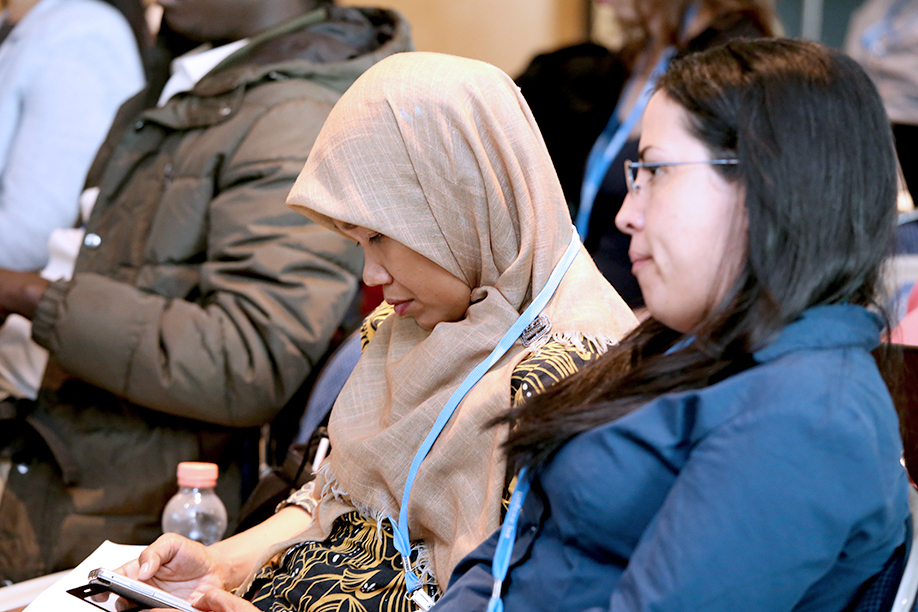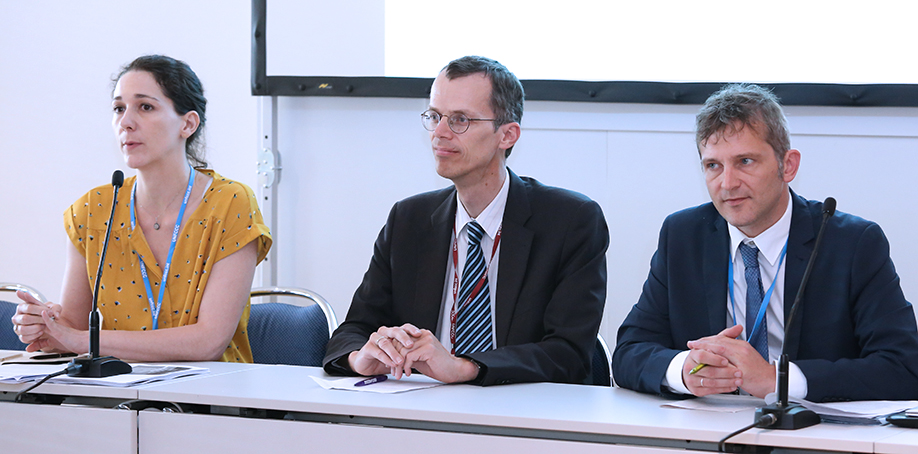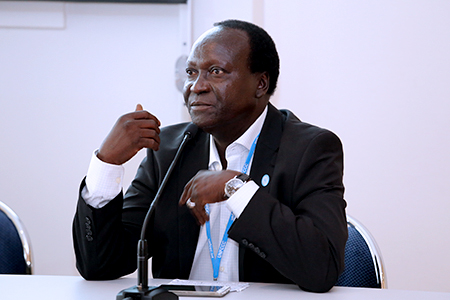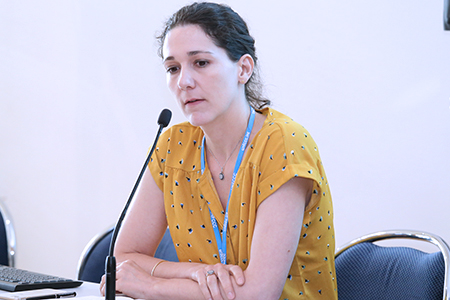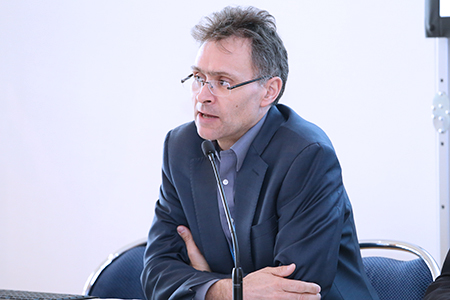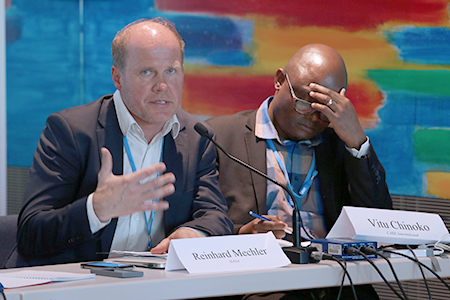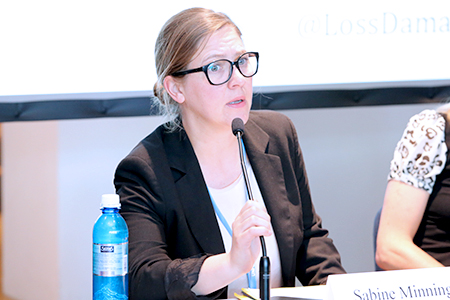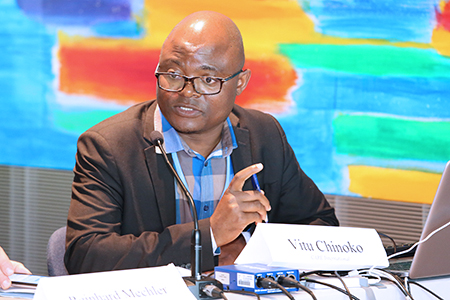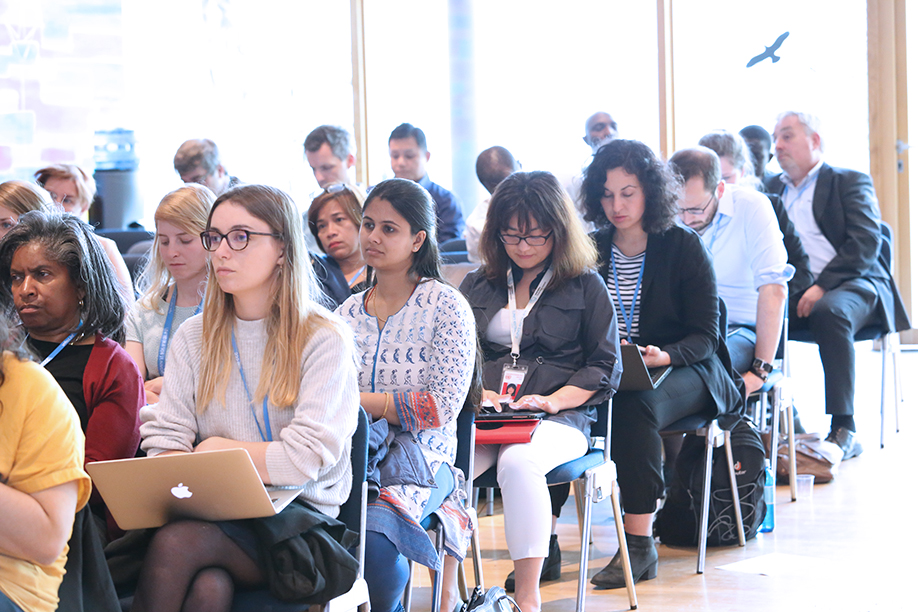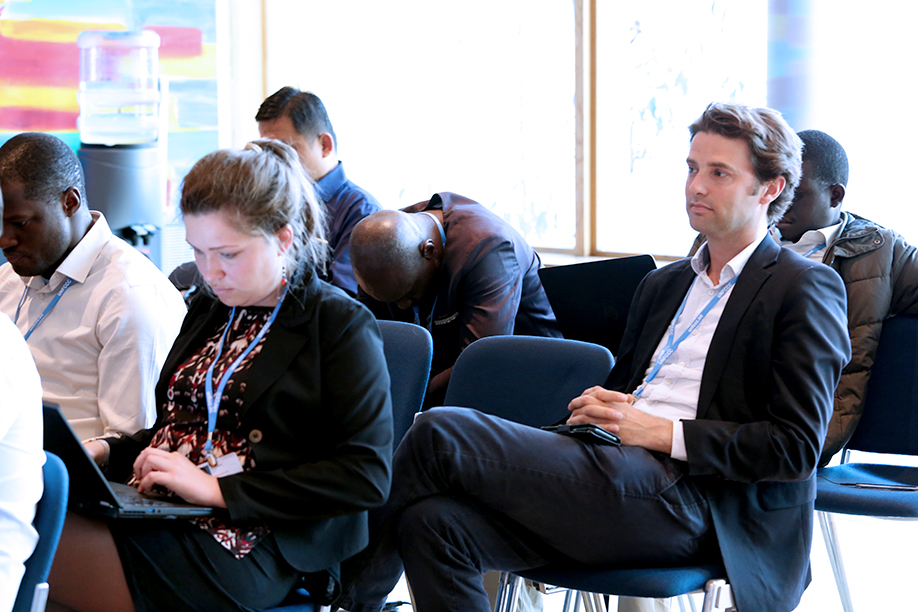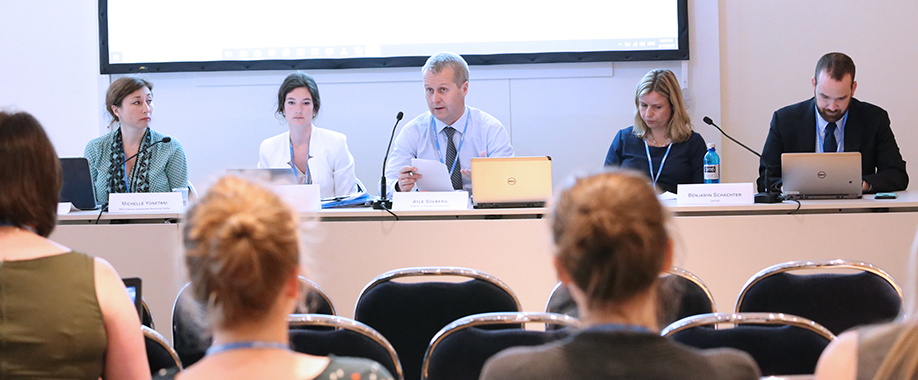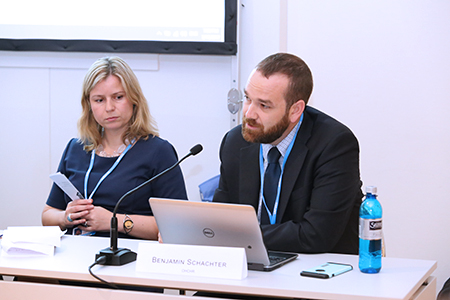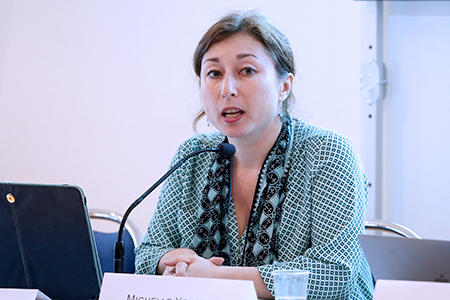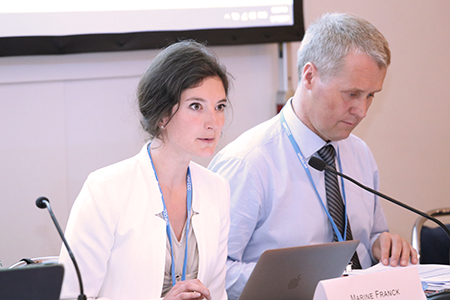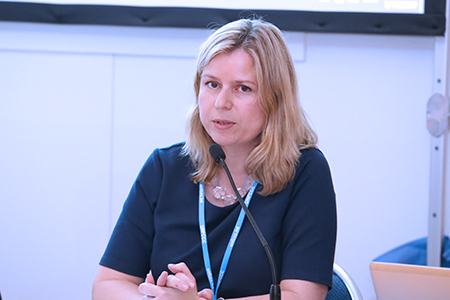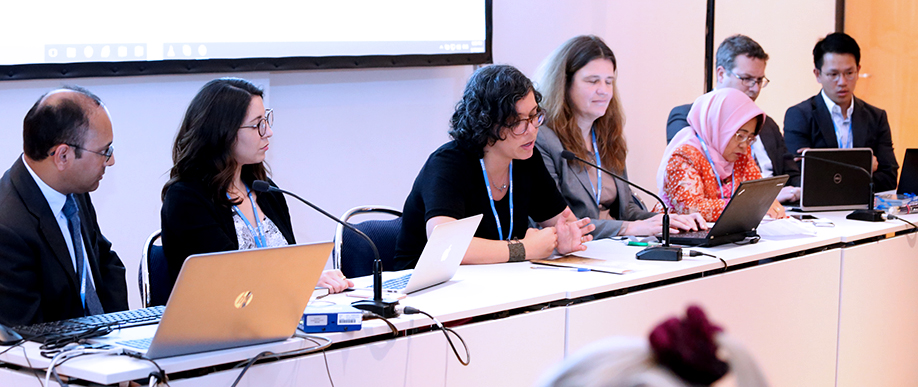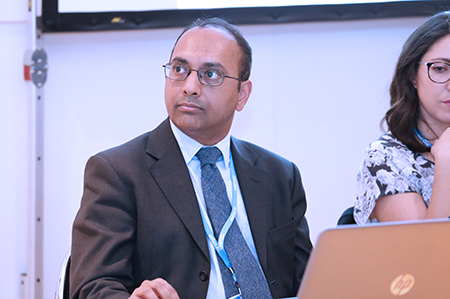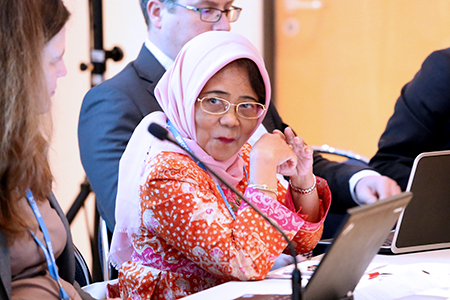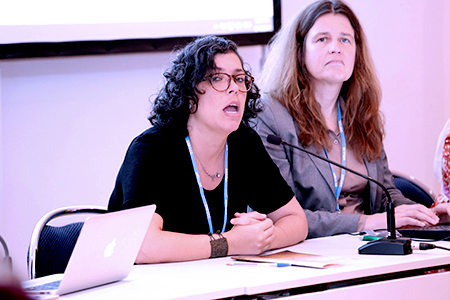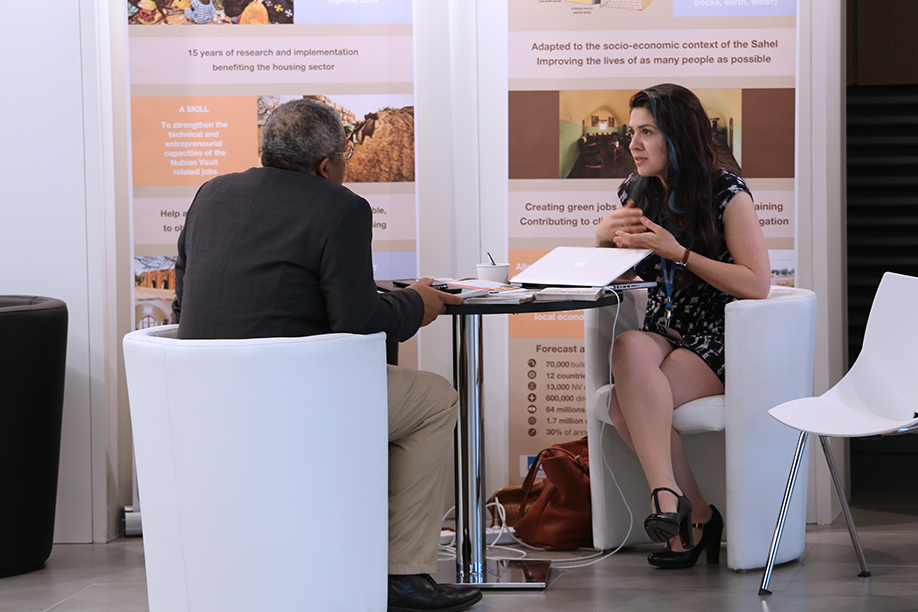Summary
The following side events were covered by ENBOTS on Wednesday, 17 May 2017:
- Addressing Vulnerability in Africa, Caribbean and Pacific Countries: Adaptation, Capacity, People
- South-South Initiatives to Support Monitoring, Reporting and Verification, and Transparency of Action and Support
- Raising Ambition in Climate and Development: Adaptation Benefit Mechanism and Sustainable Development Goals Impact Quantification
- Supporting Loss and Damage for the Most Vulnerable: Experiences from Africa and Elsewhere
- Human Mobility and Climate Change: Synergies between the UN Framework Convention on Climate Change and Other Global Policy Processes
- Contribution of Forest Landscape Restoration to Nationally Determined Contributions
IISD Reporting Services, through its Earth Negotiations Bulletin on the Side (ENBOTS) Meeting Coverage, is providing daily web coverage of selected side events at the Bonn Climate Change Conference, May 2017.
Photos by IISD/ENB | Angeles Estrada Vigil
For photo reprint permissions, please follow instructions at our Attribution Regulations for Meeting Photo Usage Page
Addressing Vulnerability in Africa, Caribbean and
Pacific Countries: Adaptation, Capacity, People Presented by the African, Caribbean and Pacific Group of States (ACP Group) and the African Union Commission (AUC)
This side event centered on a dialogue and exchange of ideas among vulnerable ACP island states, least developed countries (LDCs), and landlocked and coastal countries. Viwanou Gnassounou, ACP Group Secretariat, moderated the event.
Underscoring that “climate change is the single greatest threat to the security and livelihoods of our people,” Johnson Weru, Chair, ACP Subcommittee on Sustainable Development, highlighted close cooperation with the EU to undertake climate action and tackle other environmental problems. He noted the ACP is developing a dedicated programme to support small island developing States (SIDS) to address their unique vulnerabilities.
Olushola Olayide, African Union (AU), underscored the vulnerability of the African continent. Among key initiatives the Union is engaged in, she highlighted: Climate for Development in Africa; the High-level Work Programme on Climate Change Action in Africa; the Africa Renewable Energy Initiative; the Africa Adaptation Initiative; and the initiative for the Adaptation of African Agriculture to climate change.
Stressing that “the universality of the Paris Agreement is something we need to preserve and protect,” Elina Bardram, European Commission, highlighted the “special” nature of the ACP-EU partnership, highlighting the partnership’s potential to influence other global actors. She noted the EU is working through the Nationally Determined Contributions (NDC) Partnership and the Global Climate Change Alliance to help partner governments meet their commitments.
Deo Saran, Fiji, noted the incoming Presidency of the 23rd session of the Conference of the Parties to the UN Framework Convention on Climate Change (COP 23) and the 13th session of the Conference of the Parties serving as the meeting of the Parties to the Kyoto Protocol (CMP 13) aims to maintain the momentum and cohesiveness from the two previous COPs, in order to continue to build the international climate change agenda. He highlighted groundwork to ensure completion of the implementation guidelines of the Paris Agreement, and preparations for the 2018 facilitative dialogue as priorities for COP 23.
Kamal Djemouai, African Group of Negotiations (AGN), said there is a “vulnerability gap” in the UNFCCC process. He emphasized six key concepts that are important in this context: vulnerabilities, in their “plural form”; special circumstances; capacities and capabilities; NDCs; differentiation; and means of implementation.
Stressing that “it’s not a beauty contest” about who is the most vulnerable, Amjad Abdulla, Alliance of Small Island States (AOSIS), underlined that unity will be critical to ensure the voices of developing countries continue to be heard going forward. He said said loss and damage action should be further strengthened, and called for COP 23 to advance discussions on how the Adaptation Fund will serve the Paris Agreement.
Gebru Jember Endalew, LDC Group, said COP 23 should provide the basis for a clear roadmap on the final outcome of the Paris Agreement rulebook. He identified the 2018 facilitative dialogue as a key step to increasing ambition, and said the Group supports a political declaration at the end of 2018 to guide review of NDCs.
In the ensuing discussion, participants highlighted: COP 23 as a “COP for action”; the need for COP 23 to focus on capacity building; efforts to create “a high ambition coalition for shipping”; and the need for “all countries of the international community” to work together to defend the Paris Agreement and climate science.
L-R: Amjad Abdulla, AOSIS; Deo Saran, Fiji; Elina Bardram, European Commission; Johnson Weru, Chair, ACP Subcommittee on Sustainable Development; Olushola Olayide, AUC; Kamal Djemouai, AGN; and Viwanou Gnassounou, ACP Group Secretariat
Gebru Jember Endalew, LDC Group (center), highlighted the Renewable Energy and Energy Efficiency Initiative for Sustainable Development as crucial for reducing LDCs’ vulnerability.
Elina Bardram, European Commission, highlighted transparency and the 2018 facilitative dialogue as key issues to be addressed at COP 23.
Viwanou Gnassounou, ACP Group Secretariat, moderated the event.
Deo Saran, Fiji, stressed the need to “give confidence to the world that we are progressing at the right speed.”
Kamal Djemouai, AGN, underlined that “the more divided developing countries are, the more vulnerable they are to climate change impacts and their consequences.”
Amjad Abdulla, AOSIS, stressed: “We will all only go far if we stay united.”
A participant during the side event
Contact:
-
Pendo Maro | pendomaro@acp.int
Olushola Olayide | OlusholaO@africa-union.org
More Information:
-
http://www.acp.int/content/bonn-climate-change-conference-vulnerability-africa-caribbean-pacific-countries-adaptation-c
https://www.au.int/
South-South Initiatives to Support Monitoring, Reporting and Verification,
and Transparency of Action and SupportPresented by the Secretariat of the UN Framework Convention on Climate Change (UNFCCC)
This side event showcased South-South cooperation success stories on: technical and financial support; strengthening in-country and regional institutional capacity for monitoring, reporting and verification (MRV), and transparency of action and support in developing countries; and sharing methods, tools and data. William Agyemang-Bonsu, UNFCCC Secretariat, moderated the discussion.
Toby Hedger, UNFCCC Secretariat, presented the UNFCCC Climate Action and Support Transparency Training (UNFCCC-CASTT) programme, an initiative for national readiness for implementation of the Paris Agreement developed jointly with the Greenhouse Gas Inventory & Research Center of Korea (GIR). She explained that the programme’s objective is to promote effective and universal participation of countries in MRV and the transparency framework under the Paris Agreement through targeted, professional and comprehensive capacity building, as well as to contribute to implementation of Sustainable Development Goal 4 (quality education). She said the programme offers packages for policymakers, policy implementers, and technicians and development experts.
Jae Jung, GIR, elaborated on the Center’s collaboration with the UNFCCC-CASTT to provide a professional training programme on greenhouse gas (GHG) inventories for national experts from developing countries. He said the UNFCCC-GIR-CASTT programme has offered lectures and hands-on exercises to government officials and researchers from developing countries on GHG compilation and mitigation modeling since 2011, with 228 trainees from 52 countries successfully completing the programme.
Damiano Borgogno, UN Development Programme (UNDP) Global Support Programme (GSP), stressed the need to ensure that supported initiatives are sustainable over time, and to avoid redundancy. Among GSP-supported initiatives, he highlighted the West African South-South Network on MRV and the Latin American Network on GHG Inventories.
Agré Mathieu Richemond Assié, Côte d’Ivoire, elaborated on the West African South-South Network on MRV, highlighting its vision to have operational MRV systems in West African countries by 2020. Among the Network’s objectives, he noted: facilitating the exchange of knowledge in the energy, and agriculture, forestry and other land-use sectors; supporting capacity development activities; and creating awareness within national institutions responsible for data collection.
Diana Camila Rodríguez Vargas, Colombia, showcased the Latin American Network on GHG Inventories. She highlighted challenges faced by Latin American countries, including: development of GHG inventories; maintaining stable inventory systems over time; and adequate institutional arrangements. She said the purpose of the Network is to: maintain South-South cooperation on national GHG inventories among Latin American Spanish-speaking countries; facilitate knowledge exchange through a range of tools; and provide technical support on, inter alia, different models of institutional arrangements and strengthening capacity for using the 2006 IPCC Guidelines for National GHG Inventories.
Kirsten Orschulok, Federal Ministry for the Environment, Nature Conservation, Building and Nuclear Safety (BMUB), Germany, presented on the Partnership on Transparency in the Paris Agreement (PATPA), formerly the International Partnership on Mitigation and MRV, outlining the Partnership’s current activities to promote practical exchange and political dialogue between countries on enhanced transparency. She noted that the PATPA seeks to foster transparency, communication, networking and trust between countries by bringing together negotiators and implementers.
During the ensuing discussion, participants addressed, inter alia: the role of adaptation in the Paris Agreement transparency framework; PATPA support on transparency of adaptation and support; and eligibility requirements for participation in UNFCCC-CASTT workshops.
L-R: William Agyemang-Bonsu, UNFCCC Secretariat; Kirsten Orschulok, BMUB, Germany; Agré Mathieu Richemond Assié, Côte d’Ivoire; and Damiano Borgogno, UNDP GSP
Jae Jung, GIR, said that the UNFCCC-GIR-CASTT programme on GHG inventories provides training on reporting and review under the UNFCCC and the Paris Agreement, GHG inventory compilation and sectoral GHG MRV, among others.
Damiano Borgogno, UNDP GSP (center), introduced the GSP-supported West African South-South Network on MRV and the Latin American Network on GHG Inventories.
William Agyemang-Bonsu, UNFCCC Secretariat, noted that the UNFCCC-CASTT programme “allows us to move away from traditional workshops.”
Among the main activities of the Latin American Network on GHG Inventories, Diana Camila Rodríguez Vargas, Colombia, highlighted establishment of formal arrangements to implement the Network, and identification of barriers and support needs.
Kirsten Orschulok, BMUB, Germany, said PATPA’s formats include: partnership meetings on the margins of UN negotiations; capacity-building activities through peer-to-peer learning during technical workshops; and knowledge sharing.
Contact:
- Marlan Pillay | Mpillay@unfccc.int
More Information:
-
http://unfccc.int/national_reports/non-annex_i_national_communications/unfccc_castt/items/10261.php
https://www.transparency-partnership.net/
https://www.gir.go.kr/eng/
Raising Ambition in Climate and Development: Adaptation Benefit
Mechanism and Sustainable Development Goals Impact QuantificationPresented by the Gold Standard Foundation (GSF) and the African Development Bank (AfDB)
In this side event, panelists highlighted how sustainable development can catalyze greater climate ambition while helping developing countries meet their development objectives. Gareth Phillips, AfDB, moderated the panel.
Outlining a proposed adaptation benefit mechanism (ABM), Phillips underscored that, if created, the ABM will: use a credible and transparent process to provide a results-based mechanism; offer a price signal for adaptation benefits; and determine this price signal by verified costs defined by an approved methodology. He said that the ABM would likely be supported by: donors who wish to transfer climate funds for long-term adaptation in a “transparent, efficient and cost-effective manner”; and socially responsible corporate buyers who wish to demonstrate their global awareness to shareholders and stakeholders. Highlighting differences between the Clean Development Mechanism and the proposed ABM, Phillips stressed that: the ABM is simpler, as it is a “contract” and not an “uncapped environmental liability”; units are non-fungible and not designed for submission against an obligation; and the ABM will finance the most compelling adaptation needs.
Noting a “preponderance of mitigation” among internationally-negotiated financing mechanisms, Axel Michaelowa, Perspectives Climate Change, said that the ABM could reduce this bias. He suggested that, to avoid potential “stumbling blocks,” the ABM should ensure that: the mechanism does not “crowd out” public finance; units provide an “open choice” for the private sector; and a sufficient number of methodologies allows for a “convergence” of similar approaches and metrics.
Chebet Maikut, Uganda, emphasized that current funding mechanisms are not sufficient to meet the needs of all developing countries. He called for fully capitalizing on current funding mechanisms and innovative approaches to mobilize additional resources. Maikut said that the ABM has the potential to “liberate” private sector financing.
Questioning why it has been an “uphill battle” to include sustainable development in climate negotiations, Marion Verles, GSF, underscored that public support for sustainable development can be the “driving force” for more ambitious climate action. Recalling the Kyoto Protocol and associated trading schemes, she emphasized that negative public perception linked to poor safeguard mechanisms and poor sustainable development objectives undermined the Protocol’s credibility. Verles said that the “elements are in place” for a paradigm shift that embeds sustainable development in climate policies.
Noting that the definition of sustainable development varies between countries, Sven Braden, Liechtenstein, stressed the importance of national prerogatives. He called for tools and forums to discuss potential contradictions within the Sustainable Development Goals.
L-R: Marion Verles, GSF; Axel Michaelowa, Perspectives Climate Change; and Sven Braden, Liechtenstein
Sven Braden, Liechtenstein, noted that his country was one of the first to link Certified Emission Reductions to labeling that ensures sustainable development.
Chebet Maikut, Uganda, stressed the “moral responsibility” to finance adaptation needs of developing countries.
Marion Verles, GSF, underscored that sustainable development can be the “key element to move the needle” on climate ambition.
Gareth Phillips, AfDB, said that, in some parts of Africa, “adaptation is the new mitigation” as there is more potential for action in this area.
Contact:
-
Sarah Leugers | sarah.leugers@goldstandard.org
Gareth Phillips | g.phillips@afdb.org
More Information:
-
https://www.afdb.org/en/topics-and-sectors/initiatives-partnerships/adaptation-benefit-mechanism-abm/
Supporting Loss and Damage for the Most Vulnerable:
Experiences from Africa and Elsewhere Presented by CARE International, the ACT Alliance - Action by Churches, and Practical Action
This side event, moderated by Sven Harmeling, CARE International, discussed key definitions and principles for financing loss and damage initiatives, including through climate risk insurance, and shared findings from the African Risk Capacity (ARC), a specialized agency of the African Union.
Idy Niang, Senegal, said that the challenge before the Executive Committee (ExCom) of the Warsaw International Mechanism for Loss and Damage associated with Climate Change Impacts (WIM) in its work on a clearing house for risk transfer is to develop a sound international framework to ensure that insurance companies help vulnerable populations. He noted the R4 Rural Resilience Initiative (R4) in his country, highlighting food security among its benefits.
Sabine Minninger, ACT Alliance, hoped that the upcoming Group of 20 Summit, taking place in Hamburg. Germany, from 7-8 July 2017, will take forward Germany’s InsuResilience initiative, which aims to provide climate risk insurance coverage to 400 million poor and vulnerable people by 2020. She cautioned against addressing climate change by “dealing with the symptoms,” such as loss and damage. Minninger also urged civil society to work on making climate risk insurance premiums affordable, noting that the poorest “should not pay at all.”
Vitumbiko Chinoko, CARE International, presented on the ARC, highlighting experiences from Southern Africa. Among recommendations for the ARC, he identified the need for: capacity building on, and affordability of, climate risk insurance; enhanced participation and transparency through involving non-state actors; enabling environments; using participation of the poor as a criterion for approving applications for certificates of good standing; and a participatory monitoring and evaluation process for the whole facility that should include poor women farmers.
Swenja Surminski, London School of Economics (LSE), emphasized the importance of keeping in mind the aims and objectives behind using insurance as a tool to address loss and damage. Highlighting advantages of insurance over post-disaster aid, she noted incentivizing and enhancing risk reduction through insurance, and sharing loss and damage beyond the at-risk community through solidarity funds as key challenges to designing and implementing insurance in the loss and damage context.
Reinhard Mechler, International Institute for Advanced System Analysis (IIASA), outlined the pro-poor principles of the Munich Climate Insurance Initiative (MCII), including comprehensive needs-based solutions, client value, affordability, accessibility, participation, sustainability and enabling environments. Among transformative measures for risk management, he highlighted: pooling and sharing risks in order to diversify them; innovative instruments involving public-private partnerships; livelihood transformation; and migration. Under “curative” options, he listed loss and damage mechanisms at the national level and a displacement coordination facility.
In the ensuing discussion, participants addressed, inter alia: the role of the WIM ExCom and the clearing house for risk transfer in initiatives, such as InsuResilience; innovative sources of, and accounting for, loss and damage finance; utility of indirect insurance mechanisms for the poor; links between insurance initiatives and humanitarian networks; involvement of multilateral development banks in climate insurance; and challenges associated with covering insurance premiums for the poor.
In closing, Colin McQuistan, Practical Action, said that the key objective of the event was to “keep loss and damage on the agenda,” noting that capacity building is vital.
Sabine Minninger, ACT Alliance; Swenja Surminski, LSE; Sven Harmeling, CARE International; Reinhard Mechler, IIASA; and Vitumbiko Chinoko, CARE International
Sven Harmeling, CARE International, questioned whether insurance mechanisms have the capacity to address the growing risks of loss and damage.
Reinhard Mechler, IIASA, observed that “there is not a single market-based insurance mechanism; there is always an element of solidarity involved.”
Sabine Minninger, ACT Alliance, underscored that “climate insurance is not an answer to climate justice.”
Noting that women are the most vulnerable to climate change, Vitumbiko Chinoko, CARE International, highlighted his organization’s efforts to ensure that women are protected.
Contact:
-
Sven Harmeling | sharmeling@careclimatechange.org
Isaiah Toroitich | ikt@actalliance.org
Colin McQuistan | colin.mcquistan@practicalaction.org.uk
More Information:
Human Mobility and Climate Change: Synergies between the UN
Framework Convention on Climate Change and Other Global Policy Processes Presented by the Norwegian Refugee Council (NRC) and the Office of the UN High Commissioner for Refugees (UNHCR)
This event discussed developments relevant to the Task Force on Climate Displacement under the Warsaw International Mechanism for Loss and Damage associated with Climate Change Impacts, which was mandated by the 21st session of the Conference of the Parties to the UN Framework Convention on Climate Change to develop recommendations to avert, minimize and address displacement. Atle Solberg, Platform on Disaster Displacement (PDD), moderated the event.
Michelle Yonetani, International Displacement Monitoring Centre (IDMC), NRC, highlighted that displacement is more strongly recognized under the Sendai Framework for Disaster Risk Reduction (DRR) than under its predecessor, the Hyogo Framework for Action. Among key recommendations of the PDD to the 2017 Global Platform for DRR, she noted: preventing displacement and reducing displacement risk; addressing protection needs and promoting durable solutions to displacement; and strengthening the systematic collection and monitoring of displacement data to inform policy and planning.
Marine Franck, UNHCR, introduced the 2016 New York Declaration for Refugees and Migrants, noting processes to adopt a global compact on migration and a global compact on refugees as key outcomes. She highlighted the UNHCR’s work includes Guidelines on Temporary Protection or Stay Arrangements, which can apply in the context of climate change and disasters, and a 10-Point Plan of Action on Refugee Protection and Mixed Migration.
Dina Ionesco, International Organization for Migration (IOM), said the global compact on migration offers an opportunity to integrate climate change into key migration policy processes. She also said climate change offers an opportunity to “green” and modernize migration policy.
Noting that the human rights and vulnerabilities of those affected by slow onset events are often overlooked, Benjamin Schachter, United Nations Office of the High Commissioner for Human Rights (OHCHR), highlighted his organization’s efforts to address information gaps in this area. He underscored the importance of human rights policy coherence across different global policy processes.
Meredith Byrne, International Labour Organization (ILO), welcomed the integrated approach of the Task Force on Displacement, and noted that it provides opportunities to make linkages with the Sustainable Development Goals and is in a “unique position” to bring together experts from cross-cutting areas. Stressing that there are 150.3 million migrant workers with “enormous development potential,” she additionally highlighted ILO’s work on green jobs.
In the discussion, participants addressed, inter alia: several opportunities for civil society to engage in the global compact on refugees, including through the UNHCR’s 2017 non-governmental organization consultations; the need to raise awareness of what human rights are, and how they can be asserted; how climate finance can exacerbate human rights violations and the need for a regulatory framework to ensure businesses respect human rights; the IOM’s Environmental Migration Portal; and the need to “shine light” on good practices.
L-R: Michelle Yonetani, IDMC, NRC; Marine Franck, UNHCR; Atle Solberg, PDD; Dina Ionesco, IOM; and Benjamin Schachter, OHCHR
Benjamin Schachter, OHCHR, underscored that climate change puts human rights at risk and drives migration.
Michelle Yonetani, IDMC, NRC, said climate-related disasters cause an average of 21.5 million displacements each year.
Marine Franck, UNHCR, highlighted efforts to ensure synergies between the global compact on refugees and the Task Force on Climate Displacement.
Dina Ionesco, IOM, stressed migrants can be powerful agents of adaptation and mitigation policies.
Contact:
- Lena Brenn | lena.brenn@nrc.no
Erica Bower | bower@unhcr.org
More Information:
-
https://www.nrc.no/what-we-do/speaking-up-for-rights/climate-change/
http://www.unhcr.org/climate-change-and-disasters.html
http://disasterdisplacement.org/
Contribution of Forest Landscape Restoration to Nationally Determined Contributions Presented by the International Union for the Conservation of Nature (IUCN) and the international Institute for Applied Systems Analysis (IIASA)
This side event concentrated on the contribution of forest landscape restoration (FLR) to the achievement of Nationally Determined Contributions (NDCs). Panelists shared views on the design and successful implementation of FLR policies and practices, and discussed how FLR contributes to reducing emissions and enhancing carbon stocks in forest landscapes.
Sandeep Sengupta, IUCN, moderated the event. He noted IUCN’s Bonn Challenge, which aims to secure pledges to restore up to 150 million hectares of degraded and deforested land by 2020, and 350 million hectares by 2050.
Nur Masripatin, Ministry of Environment and Forestry, Indonesia, focused on the role of forest and land-use sectors in Indonesia’s NDC. She said that forestry is responsible for 17.2% of her country’s emissions reduction target of 29% of the business-as-usual scenario by 2030 reflected in its NDC.
Leticia Guimaraes, Ministry of Environment, Brazil, highlighted national instruments to support implementation of reducing emissions from deforestation and forest degradation and the role of conservation, sustainable management of forests and enhancement of forest carbon stocks in developing countries (REDD+), and the national plan for recovery of native vegetation, including: the Brazilian forest code which requires land owners in the Amazon biome to maintain 80% of their land as forest; and the rural environmental registry, which enables the government to track implementation of the code. She said that her country’s NDC includes a target to reforest and recover 12 million hectares of land.
Florian Kraxner, IIASA, noted that global estimates of degraded area with potential to be restored vary from 1 billion to 6 billion hectares. Highlighting the RESTORE+ project, he said it aims to: identify degraded land; assess the implications of using different degraded land definitions; and assess the sectoral interaction of the food-land-energy nexus.
Ping Yowargana, IIASA, explained the limitations of remote sensing in identifying degraded land resources and described the potential of crowdsourcing to estimate land availability for reforestation. He detailed strategies for engaging grassroots actors in data collection and verification, including, inter alia: crowdsourcing of land cover analysis; in situ data validation using mobile applications; and visualization of land cover data sets and suitability maps.
Underscoring that FLR aims to regain ecological functionality across deforested and degraded forest landscapes, María del Carmen García-Espinosa, IUCN, said that it also promotes socioeconomic benefits by improving the wellbeing of forest-dependent communities. She highlighted IUCN’s Restoration Opportunity Assessment Methodology (ROAM) to identify and prioritize FLR opportunities at the national and subnational levels, noting that ROAM has been deployed in at least 26 jurisdictions or countries.
Ruth Irlen, Ministry for the Environment, Nature Conservation, Building and Nuclear Safety (BMUB), Germany, stressed that the Bonn Challenge is about “enabling informed decision making.” She identified as key to meeting the targets of the Bonn Challenge: development of sustainable restoration models that meet national needs; and innovation to combine “big data” with crowdsourcing and ground proofing of data.
During the ensuing discussion, participants addressed, inter alia: the role of indigenous peoples in Brazil in protecting forests; developing the national REDD+ project strategy and implementing reforestation projects; resilience of community conservation and restoration initiatives; and restoration of palm oil plantation land in Indonesia.
L-R: Sandeep Sengupta, IUCN; María del Carmen García-Espinosa, IUCN; Leticia Guimaraes, Ministry of Environment, Brazil; Ruth Irlen, BMUB, Germany; Nur Masripatin, Ministry of Environment and Forestry, Indonesia; Florian Kraxner, IIASA; and Ping Yowargana, IIASA
Ping Yowargana, IIASA, highlighted strategies for “citizen-empowered scientific assessment” of land-use degradation and restoration.
Sandeep Sengupta, IUCN, moderated the event.
Nur Masripatin, Ministry of Environment and Forestry, Indonesia, said that the forest area in her country has decreased since 1990 but the rate of net forest loss has been cut by 50%.
Leticia Guimaraes, Ministry of Environment, Brazil, highlighted her country’s recent commitment to the Bonn Challenge.
Contact:
-
Sandeep Sengupta | Sandeep.sengupta@iucn.org
Susan Riley | riley@iiasa.ac.at

